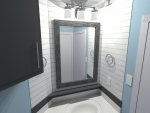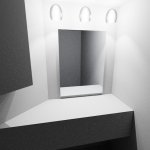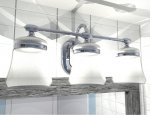MonkeyT
0
Translucency
I've been working on model of the light fixture in my bathroom. I'm perfectly happy with the model, now I'm using it to explore node textures.
The three shades on the fixture are frosted, white glass, too opaque to see through, but you can make out the light source within it.
Here, I started with the "Ocean" texture, tweaking the colors, carefully adding a bit of Emissive value and such.
I like the final effect (it lights the room well, and conveys the shape of the shade), but it looks like the entire shade is lit from behind instead of encompassing the light source. I wish it glowed from the center (where a light source has been placed in the center of the bell-shaped object). Any higher value for the Emissive setting and it blows out the entire space completely.
(I'm still getting used to the Falcon renderer.)
Does anyone have a different strategy for backlit semi-opaque stuff like this? Lamp shades, stained glass and the like?
I've been working on model of the light fixture in my bathroom. I'm perfectly happy with the model, now I'm using it to explore node textures.
The three shades on the fixture are frosted, white glass, too opaque to see through, but you can make out the light source within it.
Here, I started with the "Ocean" texture, tweaking the colors, carefully adding a bit of Emissive value and such.
I like the final effect (it lights the room well, and conveys the shape of the shade), but it looks like the entire shade is lit from behind instead of encompassing the light source. I wish it glowed from the center (where a light source has been placed in the center of the bell-shaped object). Any higher value for the Emissive setting and it blows out the entire space completely.
(I'm still getting used to the Falcon renderer.)
Does anyone have a different strategy for backlit semi-opaque stuff like this? Lamp shades, stained glass and the like?






